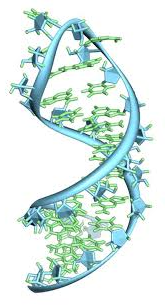 What is RNA Interference?
What is RNA Interference?
RNA interference (RNAi) also called post transcriptional gene silencing (PTGS), is a biological process in which RNA molecules inhibit gene expression, typically by causing the destruction of specific mRNA molecules. Historically, it was known by other names, including co-suppression, post transcriptional gene silencing (PTGS), and quelling. Only after these apparently unrelated processes were fully understood did it become clear that they all described the RNAi phenomenon. In 2006, Andrew Fire and Craig C. Mello shared the Nobel Prize in Physiology or Medicine for their work on RNA interference in the nematode worm C. elegans, which they published in 1998.
What does this mean to the EMF research world?
There are more and more studies world wide piling up showing many different health effects, both good and bad, from EMF sources in our environment. One that seems to be a key to the research is RNA Interference. This process actually silences certain genes so that cells do not function properly. It is a very complex and still being understood matter but could explain one of the many health effects of the damaging effects of EMF’s.
Living near large power lines, using cell phones, and more sources are all known to affect cells in negative ways by disrupting biochemistry. If EMF’s damage DNA enough it could cause RNA Interference which would cause cells to malfunction, die off, or accelerate growth such like in cancer.
In a paper published in the January 1990 issue of Radiation Research (121. pp.38-45). Dr. Stephen Cleary reported that RF/MW radiation had pronounced effects on the DNA and RNA synthesis of glioma cells, as measured by the incorporation of thymidine and uridine-genetic building blocks.
Five days after a two-hour exposure to radio frequency and microwave (RF/MW) radiation, human brain tumor cells continued to proliferate at an abnormally high rate. At higher
levels, however, the radiation suppressed cell growth. The researchers found highly statistically significant enhancement at specific absorption rates (SARs) of 5 or 25 W/ Kg. At higher SARs, cell growth was suppressed. Essentially the same effects were obtained for exposures to unmodulated 27 MHz and 2450 MHz radiation. The cells were kept at a constant temperature during ex- posure, allowing the authors to conclude that the “effects were not induced indirectly by heating.”
This indicates that the exposure of these regularly experienced frequencies may be one of many reason that cells do not operate properly when around them. Even though this is more than likely only one of many different biological effects that have been noticed, using this knowledge to create devices to target living things could prove to be used in weaponry. A silent yet potent device such as these may already be near your home, school, or workplace in the forms of power lines, cell phones, radio towers, and more.
This same research may help understand how we can combat the illnesses caused by them as well, but at this point the medical industry is pursuing pills from pharmaceuticals that chemically perform these gene silencing functions.
Is there a positive effect of RNA Interference? Can it help fight cancer?
Pennsylvania State University Researchers Zero in on Small Interference RNAs (siRNAs) – NewsRX Health Articles
Investigators discuss new findings in Small Interference RNAs (siRNAs). According to news reporting from Hershey, Pennsylvania, by NewsRx journalists, research stated, “CD47 is a ‘self marker’ that is usually overexpressed on the surface of cancer cells to enable them to escape immunosurveillance. Recognition of CD47 by its receptor, signal regulatory protein alpha (SIRP alpha), which is expressed in the macrophages, inhibits phagocytic destruction of cancer cells by the macrophages.”
The news correspondents obtained a quote from the research from Pennsylvania State University, “In this study, we have first shown that clinical isolates of human melanoma significantly upregulate CD47, possibly as a mechanism to defend themselves against the macrophages. We then exploited RNA interference (RNAi) technology to test the hypothesis that knocking down CD47 in the tumor cells will render them targets for macrophage destruction; hence, creating a novel anti-cancer therapy.
Anti-CD47 siRNA was encapsulated in a liposome-protamine-hyaluronic acid (LPH) nanoparticle (NP) formulation to address the challenge of targeted delivery of siRNA-based therapeutics in vivo. Efficient silencing of CD47 in tumor tissues with systemic administration of LPH(CD47) also significantly inhibited the growth of melanoma tumors. In a lung metastasis model, LPH(CD47) efficiently inhibited lung metastasis to about 27% of the untreated control. Moreover, no hematopoietic toxicity was observed in the animals that received multiple doses of LPH(CD47).” The research concluded: “Our findings indicate CD47 as a potential prognostic marker for melanoma development as well as a target for therapeutic intervention with RNAi-based nanomedicines.”
